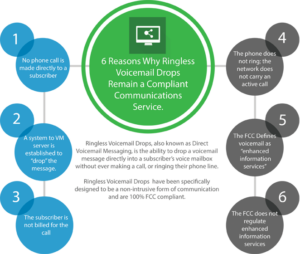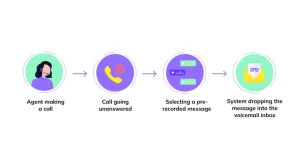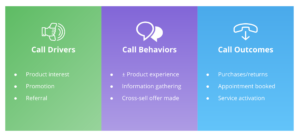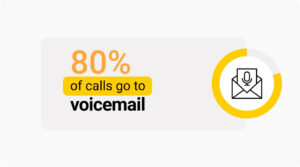In today’s fast-paced business world, staying connected with customers and prospects is essential for growth. However, traditional methods of communication, such as cold calls and email marketing, often fall short in terms of efficiency and engagement. Enter voicemail drops — an innovative tool that allows businesses to reach their customers effectively without the need for live conversations. We explore the power of voicemail drops, how they work, their benefits, and how to implement them as part of your marketing strategy.
What is a Voicemail Drop?
A voicemail drop is a technology that enables businesses to leave pre-recorded voice messages directly into a customer’s voicemail box without the phone ever ringing. This technique is different from making a direct call and waiting for it to be answered; it’s an automated solution that delivers your message seamlessly. Voicemail drops are typically integrated with a calling system or CRM software that allows businesses to reach out to many customers in a short time, maximizing efficiency and reach.
Voicemail drops have gained traction as a method for communicating important information, following up on leads, making appointment reminders, and delivering promotional messages. These messages are often concise, engaging, and tailored to capture the attention of the listener, ensuring they hear the core message even if they don’t answer their phone.
How Voicemail Drops Work
Voicemail drops function by bypassing the ringing stage and directly inserting a pre-recorded message into the recipient’s voicemail inbox. Here’s a step-by-step look at how they typically work:
- Integration with a Dialer or CRM: Voicemail drops are integrated with an auto-dialing system or a CRM platform. The software automatically dials a list of contacts from a preloaded database.
- Automated Call Handling: When the call is connected, the system detects if it has reached a voicemail. If the call reaches voicemail, the pre-recorded message is delivered and dropped into the voicemail box.
- Message Personalisation: Many voicemail drop systems offer the ability to personalise messages with the recipient’s name or specific details, making the communication feel more direct and relevant.
- Follow-Up Opportunities: Some voicemail drop solutions are linked to a larger marketing or customer service strategy, allowing businesses to track responses and trigger follow-up actions based on customer interaction.
Why Use Voicemail Drops?
Voicemail drops provide businesses with a unique set of advantages, making them an appealing choice for marketers looking to enhance their outreach strategies. Here are some of the primary benefits:
1. Higher Engagement Rates
Voicemail drops have been shown to yield higher engagement rates compared to traditional cold calls or emails. With a well-crafted message that’s delivered directly to a customer’s voicemail, there’s a greater chance that the recipient will listen to it at their convenience, especially when compared to a phone call that may be ignored or missed.
2. Cost-Effective Communication
Compared to live calls, voicemail drops are significantly more cost-effective. They eliminate the need for agents to spend time dialing numbers and waiting for responses, allowing them to focus on high-priority tasks or live interactions that require more attention. Voicemail drops enable businesses to scale their outreach efforts without increasing labour costs.
3. Time-Saving
Voicemail drops can be sent to hundreds or even thousands of contacts in a short period, making them a powerful tool for bulk messaging campaigns. The automation reduces the manual work involved and ensures that businesses can reach out to a larger audience with minimal time investment.
4. Consistent Messaging
Automated voicemail drops ensure that every message is consistent, professional, and delivers the intended tone and content. This consistency helps maintain the brand voice and ensures that all customers receive the same high-quality information.

Common Use Cases for Voicemail Drops
Voicemail drops are a versatile communication tool and can be effectively used across a wide range of industries for various purposes. Here are some of the most common use cases:
1. Appointment Reminders
For businesses in sectors like healthcare, real estate, or service industries, appointment reminders are critical for reducing no-shows and maintaining schedules. Sending a voicemail reminder ensures that the message is received and heard by the recipient, even if they’re unable to answer their phone at the time of the call.
Example: “Hi [Name], this is [Your Name] from [Business Name]. Just a friendly reminder that your appointment is scheduled for [Date] at [Time]. If you have any questions, please call us at [Phone Number]. Looking forward to seeing you!”
2. Lead Follow-Up and Nurturing
After initial contact with a lead, following up with a voicemail drop can keep your business top-of-mind without having to engage in real-time conversations. This helps to nurture the relationship and move potential customers down the sales funnel.
Example: “Hello [Name], this is [Your Name] from [Business Name]. I wanted to reach out and thank you for your interest in our services. If you have any questions or need more information, don’t hesitate to reach out. We’re here to help!”
3. Promotional Campaigns
Businesses can use voicemail drops to deliver promotional offers, discounts, or news about upcoming events. The personal touch of a voice message can make recipients more likely to act on the offer or visit a website.
Example: “Hi [Name], we’re offering an exclusive 20% discount on all products this week only! Visit [Website URL] or call us at [Phone Number] to take advantage of this special offer.”
4. Customer Service Updates
Keeping your customers informed is essential for building trust and maintaining a good relationship. Voicemail drops can be used for informing customers about service updates, product recalls, or any important changes in business operations.
Example: “Hello [Name], this is [Your Name] from [Business Name]. We’re letting you know that our service hours have changed to [New Hours]. If you need any assistance, please contact us during our new operating hours.”

Best Practices for Creating Effective Voicemail Drops
Crafting a voicemail drop that engages and connects with the recipient requires careful planning and attention to detail. Here are some best practices to ensure your voicemail drops are effective:
1. Keep It Short and to the Point
Customers are more likely to listen to and respond to brief messages. Aim to keep your voicemail drop under 30-45 seconds, focusing on one clear message or call to action.
2. Personalise the Message
While voicemail drops are automated, adding personal touches, like the recipient’s name or other specific details, can make the message feel more relevant and increase the chances of engagement.
3. Use a Friendly and Professional Tone
The tone of your message should reflect your brand’s personality and convey trust and professionalism. A friendly, upbeat voice helps keep the message engaging and approachable.
4. Include a Clear Call to Action
What do you want the recipient to do after hearing your message? Make sure to include a clear and concise call to action, whether it’s visiting a website, calling back, or taking advantage of an offer.
5. Test and Optimise
It’s essential to test different scripts and messaging strategies to determine what resonates best with your target audience. Pay attention to metrics such as response rates and engagement, and optimise your voicemail drops accordingly.

Challenges and Considerations
While voicemail drops offer numerous benefits, it’s essential to approach them thoughtfully and consider the following challenges:
1. Compliance with Regulations
Ensure your voicemail drop campaigns comply with local, state, and federal regulations, such as the Telephone Consumer Protection Act (TCPA). These regulations may vary based on your location, so it’s essential to stay informed and seek legal advice if needed.
2. Customer Perception
Some customers may find unsolicited voicemail drops intrusive or bothersome. To maintain trust, make sure your messages are relevant, provide value, and offer recipients the option to opt out of future messages.
3. Quality of the Message
A poorly recorded or unclear voicemail can damage your brand’s reputation. Invest in quality recording equipment or work with professional voice actors to ensure the message is clear and engaging.

Advanced Strategies for Leveraging Voicemail Drops
While basic voicemail drop campaigns can be effective on their own, there are advanced strategies that can take your outreach to the next level. These strategies involve combining voicemail drops with other marketing tools, personalisation techniques, and customer segmentation to create even more impactful campaigns.
1. Integrating Voicemail Drops with Email and SMS Campaigns
One of the most effective ways to amplify the reach of your voicemail drops is by integrating them with other communication channels such as email and SMS. This multi-channel approach ensures that your message reaches customers through various touchpoints, increasing the likelihood of engagement.
Example: After sending out a voicemail drop about an upcoming sale, follow up with an email or SMS that reiterates the main points, provides additional details, or offers a direct link to the sale page. This reinforces your message and gives customers a convenient way to take action.
Best Practice: Time your follow-up messages strategically so that they complement the voicemail drop rather than overwhelming the recipient with too much information at once. For instance, you could send an email a few hours after the voicemail or an SMS reminder the next day.
2. Utilising Data Analytics to Refine Campaigns
Data analytics plays a vital role in understanding how well your voicemail drop campaigns are performing and where improvements can be made. By analysing key metrics such as open rates, response rates, and conversion rates, you can make data-driven decisions to optimise your future campaigns.
Example: If you find that your voicemail drops are most effective when sent on weekdays between 9:00 am and 12:00 pm, you can use this insight to schedule future messages at the optimal time. Similarly, if specific segments of your audience are responding better than others, you can tailor your messages accordingly.
Tip: Use A/B testing to experiment with different scripts, tones, and calls to action to identify which combinations yield the best results. This helps you fine-tune your approach and continually increase your ROI.
3. Segmenting Your Audience for Targeted Outreach
Not all customers have the same needs or preferences, which is why segmenting your audience is crucial for effective voicemail drops. By creating customer segments based on demographics, purchasing history, or behaviour, you can deliver highly targeted messages that are more relevant and engaging.
Example: A business selling high-end skincare products could send different voicemail drops to new customers versus repeat buyers. While a new customer may receive a welcome message and an introduction to the brand, a repeat buyer might get a voicemail offering a special loyalty discount or early access to a new product.
Strategy: Use customer data from your CRM or marketing platforms to create segments and send customised voicemail drops that appeal to the unique characteristics of each group.

4. Personalisation Techniques for Higher Engagement
Personalisation is a key factor in making your voicemail drops stand out and resonate with the recipient. The more personal and relevant your message is, the more likely it is that the customer will take action.
Examples of Personalisation Techniques:
- Dynamic Content: Use dynamic placeholders to insert customer names or specific details (e.g., “Hi [Name], we noticed you’ve been interested in our [Product].”)
- Location-Based Messaging: For businesses with a physical presence, mention the recipient’s location in the voicemail drop (e.g., “We’re excited to announce our new store opening in [City]! Come visit us for exclusive promotions.”)
- Behavioural Triggers: Send voicemail drops triggered by specific customer actions, such as a recent purchase, cart abandonment, or website visit.
Advanced Tip: Integrate your voicemail drop system with an AI-powered CRM that uses predictive analytics to anticipate what kind of message or offer would be most appealing to a customer based on their history and preferences.
5. Incorporating Interactive Elements
While voicemail drops are traditionally one-way communications, adding interactive elements can make them more engaging and encourage the recipient to take immediate action.
Examples of Interactive Features:
- Call-to-Action Prompts: Include prompts that direct customers to a response line, website, or text message reply. For example, “To learn more, visit our website or text ‘INFO’ to [number].”
- Survey Requests: Add a short prompt at the end of the voicemail asking customers to respond to a quick survey to share their feedback or preferences.
- Tracking Codes: Include a unique code that the recipient can use to access a special offer or discounted product, making it easy to track which voicemail drops are most successful.

6. Building Trust and Transparency
Building trust through voicemail drops is essential for maintaining a positive brand image. Customers are more likely to respond favourably to your messages when they feel the brand is transparent and respectful of their time.
Best Practices for Trust-Building:
- Introduce Yourself Clearly: Always state who you are and what your business does at the beginning of the message.
- Provide an Opt-Out Option: Respect customers’ preferences by giving them the option to opt out of receiving future voicemail drops.
- Be Honest and Direct: Ensure that your voicemail messages are straightforward and deliver what was promised. Misleading or vague messages can damage trust and result in negative perceptions.
7. Leveraging Voicemail Drops for Customer Feedback
Feedback is a powerful tool for refining your marketing strategy and improving customer experience. Using voicemail drops to collect feedback can give you valuable insights into what customers think about your products or services.
Strategies for Collecting Feedback:
- End With a Question: Add a question at the end of your voicemail asking customers to call a feedback line or visit a survey link to share their thoughts.
- Follow-Up Voicemail: Send a follow-up voicemail asking for a brief response, ensuring customers that their opinions matter to your business.
- Incentivise Participation: Offer incentives like discounts or promotional codes to customers who complete a feedback survey.
8. The Role of Compliance in Voicemail Drops
Before implementing voicemail drop campaigns, it’s essential to understand the legal landscape. Depending on your location, there may be regulations that dictate how and when you can use voicemail drops. Compliance not only helps you avoid penalties but also ensures that your customers trust you as a responsible and respectful brand.
Key Compliance Considerations:
- Adhere to the Telephone Consumer Protection Act (TCPA): This U.S. regulation restricts the use of prerecorded voice messages, including voicemail drops, and requires that businesses obtain consent before contacting individuals.
- Transparency: Always identify your business name and provide a clear way for customers to opt out of future communications.
- Time Restrictions: Ensure your voicemail drops are sent during appropriate hours to avoid disturbing customers during off-hours.

Unleash the Potential of Voicemail Drops
Voicemail drops are a powerful tool that can revolutionise how businesses reach their customers. By adopting best practices such as personalisation, strategic integration, and compliance, businesses can harness the full potential of this technology and drive higher engagement rates, cost savings, and improved customer relationships. With careful planning and execution, voicemail drops can become an integral part of your communication strategy, setting your business apart in today’s competitive market.

